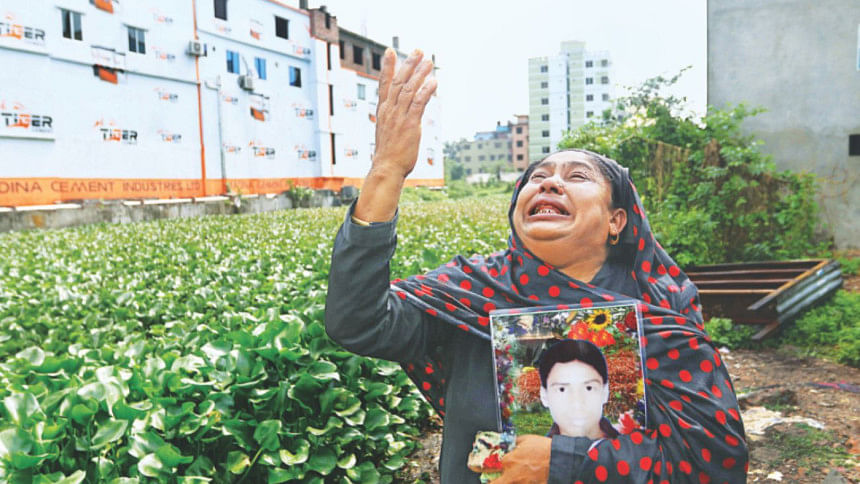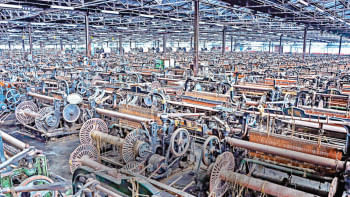Still lost in the depths of sorrow

Mazeda Begum's eyes filled with tears as she stood in silence. It was raining heavily and she looked pale. Suddenly, the 48-year-old burst into tears.
Those near the woman from Rajbari tried to console her but in vain. She kept on sobbing.
At one point, she passed out.
Every year on the morning of April 24, Mazeda, who lost her only daughter Lipi Akhter in the Savar Rana Plaza tragedy on that day in 2013, visits a small memorial built near a hyacinth-filled low-land, which once had a nine-storey building on it.
Yesterday was not any different. Like her, relatives, survivors along with different trade union leaders and activists paid tribute to the Rana Plaza victims by placing wreaths at the sculpture of a hammer and sickle. The structure was built to commemorate the Rana Plaza victims.
In one of the world's worst disasters, over 1,135 workers were killed after the building collapsed near Savar bus stand on the outskirts of the capital.
Their families and the survivors, many of whom were crippled, are still reeling from the shock of the incident that also raised a worldwide hue and cry about workers' safety in Bangladeshi garment factories.
Lipy Akhter, 18, had been working as a helper at a factory housed on the third floor of the Rana Plaza since January 2013.
The night before the tragedy struck, Lipi called her mother, Mazeda, over phone and told her that cracks had developed on some walls of the building.
Lipi also said she would meet her family in Rajbari's Goalanda on receiving her monthly wage for April. She could not keep the promise.
"My daughter always wanted to see us happy. But sadly, today she is not among us,” Mazeda told The Daily Star, after she regained consciousness.
Lipy's body was traced three days after the disaster and was buried in Goalanda later on.
However, many were not that lucky as Mazeda who could see her loved one for the one last time.
Rickshaw-puller Rahim Sheikh, 46, could not even find the body of her daughter Sohima Begum, who used to work at a garment factory in the building.
Officials conducted his DNA tests later and found that his daughter had already been buried in the Jurain graveyard in the capital.
The family used to live in a rented house in Savar. After Sohima's death, they were so disturbed that they left Savar and returned to their village home in Tangail's Nagarpur.
The story of Afroza Begum, 30, is also heartrending. A worker at a garment factory housed on the seventh floor of the building, Afroza was rescued six hours after it collapsed.
She still suffers from acute pain in her backbone and other parts of her body.
“I cannot sit or walk properly. It is very painful," said Afroza, a jobless mother of four children, who came from Gaibandha.
According to a survey by NGO Action Aid, 42 percent of the Rana Plaza survivors are still unemployed. Of them, 48.1 percent are physically weak and 33.4 percent psychologically.
Expressing frustration at her current state, Afroza said, "It would have been much better if I had died that day. No one can understand the pain I have been going through.”
POLICE INTERCEPT RALLY
Workers and activists who yesterday went to the Rana Plaza site to pay tribute alleged that police prevented them from forming a human chain there.
"Don't we have the right to mourn? This is unfortunate,” said Noor Jahan, sister of a deceased worker, Al Amin.
Meanwhile, police allegedly baton-charged leaders and activists of Bangladesh Garment Sramik Trade Union Kendra as they gathered near the site to hold a procession in the afternoon.
At least six people were injured. They took primary treatment at a local clinic, said the body's Organising Secretary Khairul Mamun Mintu.
Contacted, Savar's Assistant Superintendent of Police Mahbubur Rahman rejected the allegation. He claimed police removed the activists peacefully from the highway to avoid traffic jam.
The leaders of different trade unions demanded trial for the loss of life in incidents like Rana Plaza collapse and Tazreen fire, safety of garment workers and compensation to the victims.
Meanwhile, relatives and labour activists also went to the Jurain graveyard to pay tribute to 291 unidentified Rana Plaza victims buried there.


 For all latest news, follow The Daily Star's Google News channel.
For all latest news, follow The Daily Star's Google News channel. 



Comments